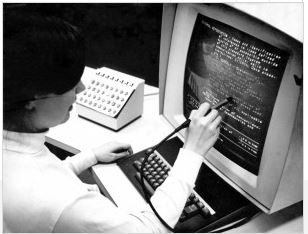The human-computer interface has been a problem since the dawn of computers. As far as smartphones are concerned, the clear winner is the touchscreen. But how did we get here?

Theproto-touchscreen was the light pen, which was first developed in the 50s and 60s and was available to consumers as an accessory for 8-bit computers in the 80s. The light pen is a simple but clever solution that works only with CRT monitors - it senses the electron beam as it scans across the phosphor drawing the image line by line, pixel by pixel. When the beam is sensed by the pen, the computer just makes a note of which pixel was being drawn at the time, that's how it knows where the pen is on the screen
In the 80s a different solution was developed - infrared beams criss-crossed the screen. Touching the screen (with a finger or stylus), blocked some of the beams and the computer registers a press. This kind of tech was used by Neonode, one of the earliest all-touch phones (the N1 came out in 2003). The company left the phone business quickly, but still makes touchscreen kits for computers.
The PDA and early touchscreen smartphone eras were defined by the resistive touchscreen. It featured two thinly-separated layers, which would make an electrical connection when you press down on them. Styluses were typically used as their thin tips reduced the force required to press down and were more accurate on the fairly small screens.
The Sony Ericsson P800 put an interesting twist to it. It was an all-touch phone (running Symbian UIQ), but it hedged its bets and offered a flip-out keypad (this was in 2002, all-touch devices were rare). The keypad simply had styluses on the back of each screen, so pushing a key really pressed the touchscreen behind it.
Capacitive touchscreens work another way - your finger changes the capacitance of the screen, which is picked up by a sensor grid. This is designed to work specifically with fingers, so most styluses (or even gloved fingers) don't work. Apple didn't invent capacitive touchscreens, but the original iPhone was certainly the most major contributor in their rise to stardom.



